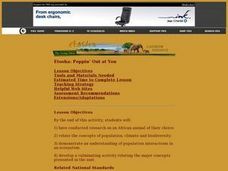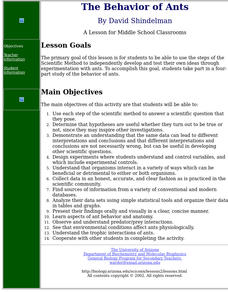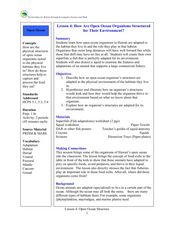Curated OER
Living it up with plants
Have kids in grades K-2 discuss how they know a tree is alive. The worksheet provides simplistic background information and an observation check list. They check off the ways that they can tell an oak tree is a living thing. Note: The...
Bridge
Mercury - Mercury is Rising
Hold a discussion in your class about the increase in mercury being found in fish that are caught commercially as food for humans. Given a worksheet, learners then calculate how much fish a person can safely eat each month to remain...
Curated OER
A Day in the life of...
Students read about and study insects--their distinguishing characteristics, habitats, camouflage methods, defense mechanisms, etc. They draw pictures and write a story from the viewpoint of an insect and share their pictures and stories...
Curated OER
Virtual Nature Walk
Students use the internet to take a virtual nature walk. Identifying animals found in specific forest habitats, they list their characteristics. They research various animals using the internet and create a PowerPoint slideshow with the...
Curated OER
It's a Jungle Out There: How Species Survive in the Jungle
Students investigate the different adaptation and skills of jungle species. In this ecology lesson, students play an interactive online game where they match species with their adaptation. They research about a specific adaptation and...
Curated OER
The Great Horned Owl
For this recognizing facts about the Great Horned Owl worksheet, students read fun facts, match illustrations with adaptations, sequence life cycle cards, and read what to do if they find an injured bird. Students solve 16 answers.
Curated OER
What Is Happening To My Species?
Learners select and research an animal that lives in the rainforest of Manu, Peru. They watch and discuss a video, create masks and costumes to role-play various rainforest animals, conduct research, and write a short story of their...
Curated OER
Etosha: Poppin' Out at You
Tenth graders research an African animal of their choice and relate the concepts of population, climate and biodiversity to their animal. They examine how population interacts in an ecosystem.
Curated OER
Camouflage
First graders learn how plants and animals adapt to their environments. In this camouflage lesson plan, 1st graders watch a movie that explains animal camouflage, design a butterfly that blends into a classroom habitat, create a...
Curated OER
Trout Cookies
Students explore the external anatomy of a fish. In this anatomy and adaptations instructional activity, students look at an image of a trout and identify its various external features including fins, eyes, spots, parr marks and lateral...
Curated OER
Food Chains
Fourth graders study food chains, producers, consumers, and decomposers. They play a food chain game and create food chain mobiles or posters. They take a nature hike around the school and observe various parts of a food chain.
Curated OER
The Behavior of Ants
Students use the steps of the Scientific Method to develop and test their own ideas through experimentation with ants.
Curated OER
Food Chains & Food Webs
Tenth graders examine how energy is lost through different trophic levels. In this trophism instructional activity students construct a food web and view a video.
Curated OER
Build a Polyp
Learners research coral polyps. For this coral polyps lesson, students discover the anatomy of a coral polyp and how they feed. Learners create an edible coral polyp model.
Curated OER
Co-evolution of Plants and Pollinators
Young scholars explore biological evolution and natural selection and its evolutionary consequences. They also explore how organisms are interdependent on one another.
Curated OER
Camouflage
Third graders collect insects and various bits of the insects' habitats in order to develop an understanding of how camouflage makes the insect fit to survive in its environment.
Curated OER
Kure Waste Chase Game Lesson
Students work together to identify marine debris. They explain the effect of the debris on various ecosystems. They draw different types of ocean currents as well.
Curated OER
Whale Watcher Game Lesson
Students participate in an online whale watching game. They identify the reasons for migration and describe the route. They make predictions on what would happen if the ways did not migrate.
Michigan Sea Grant
Invasive Species
Learners identify invasive species to the Great Lakes and analyze their impact on the ecosystem. Using photo cards with pictures and facts, young scientists work in small groups to match invasive species with their corresponding...
Curated OER
The Big Hideout
Students identify the types of camouflage used by animals in the desert. They work together to create their own animal creating their own type of camouflage. They determine how well the camouflage works.
Curated OER
Management of Wildlife Resources
Young scholars investigate how wildlife management policies affect the size of large animal populations. They develop a spreadsheet that incorporates a mathematical model to predict big game herd sizes, and using worksheet data manage a...
Curated OER
Bird Beaks and Feet
In this bird adaptations worksheet, students look at different bird pictures and determine what the bird eats and where it lives by looking at its beak and feet. Students complete a graphic organizer and 5 short answer questions.
Curated OER
Insect Conservation
Students make a diorama. In this insect lesson, students review what they know and what they need to know about insects. Students define conservation, discuss why it is important to conserve insects, and make an insect diorama.
Curated OER
How Are Open Ocean Organisms Structured for Their Environment?
Students explore biology by conducting an animal dissection. In this oceanography lesson, students identify the life cycle of a squid and other animals that are involved with commercial fishing. Students dissect a squid in class and...























